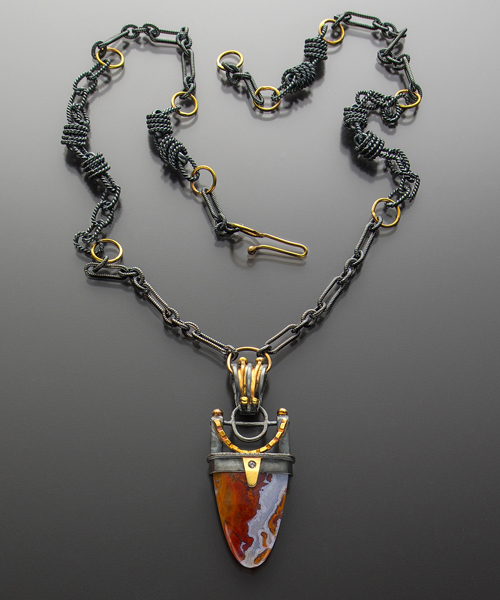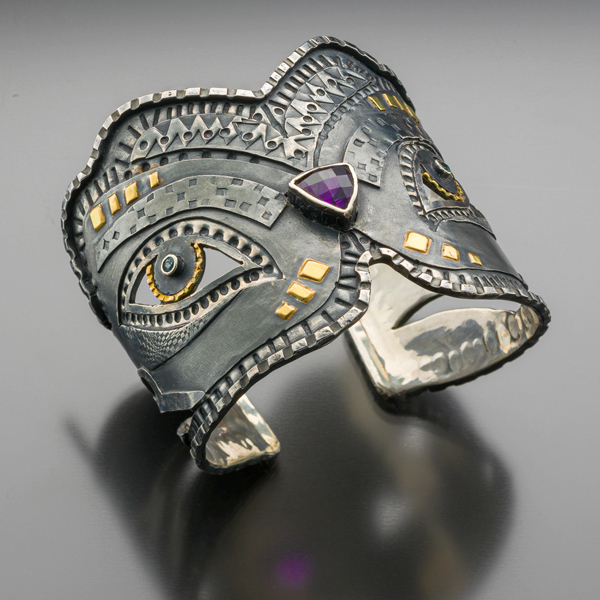Susan Cummins: Does your show have a title? If so, can you explain its meaning?
Marthe Roberts/Shea: No, my show doesn’t have a title. Sometimes a title gets in the way of the actual show. My goal is to display the pieces and let everyone draw their own conclusions.
Marthe, I noticed on your resume that you graduated from Moore College with a BFA double major in illustration and design. How did you end up making jewelry?
Marthe Roberts/Shea: I was a graphic designer and illustrator for quite a few years, during which time I was an art director for Dupont deNamours and then later CIGNA Corporation. I discovered that corporate culture is not necessarily a friend of creativity. After that I owned my own design firm for about 20 years, competed for and won more than 234 design awards, and found that I really wasn’t fond of the “good ol’ boy” network. I really tried to break through and become one with my peers—but it just wasn’t going to happen no matter how hard I tried. I wanted to stay creative—just not in that atmosphere.
Where did you get your training?
Marthe Roberts/Shea: It took three tries to become interested in making jewelry. The first time, a friend asked me to enroll in a jewelry-making class at a nearby art center. The class was bedlam! The only students who got the teacher’s attention were the ones who yelled the loudest. We received minimal instruction and pretty much had to figure out how to use most of the tools ourselves.
I felt as if I hadn’t given jewelry making a fair chance so I enrolled in a second class, with a different teacher at the same art center. This time the teacher finished the students’ projects for them—so nobody learned anything.
I was about to give it up when another friend asked if I would like to take a jewelry-making class at the local adult night school. I dubiously agreed. The first night of class was like magic. There were about 17 people—some were old hands at jewelry making, some were total beginners, and I was somewhere between the two groups. The instructor pulled all of the new students aside and explained the classroom layout and use of tools. He also made it clear that this was a serious class and that he had no patience for drama.
It was at this school that I started my “real” training. I loved every minute of these classes. I learned a lot of useful basic techniques. The “old hands” were very forthcoming with useful jewelry-making information. I was the one in class who had the crazy creative ideas that far outweighed her technical skills! My teacher worked with me, and when we came to an area that he was not familiar with, we would “study up” and learn together. Eventually, he kicked me out of class, telling me that I had learned everything he could teach me. I felt as if I had been orphaned—but I understood.
I continued my training by reading, and taking workshops and classes. Then, my husband bought me a torch—and the rest is history!

You live in Philadelphia, where there is a large population of jewelers. Are there organizations or groups that bring you together? How do you relate to the others in town?
Marthe Roberts/Shea: I belong to the Pennsylvania Guild of Craftsmen and am president of the Pennsylvania Society of Goldsmiths. I live in the suburbs and one of my neighbors is a glass artist who makes beautiful iridescent beads. She also teaches at one of the schools where I teach. We often compare notes. Another good friend is a seed bead artist. Her work is phenomenal. We often talk about the business of art. A third friend is a lapidary. He cuts stones to my specifications. He teaches, as well, and often refers his stone-cutting students who want to learn metalsmithing to me. I don’t really know many jewelers in town, but I know many jewelers—all over the U.S. and abroad.
I teach intermediate and advanced metalsmithing and continually meet professional-level jewelers in my classes. I also became a member of the larger jewelry community when I started writing articles for Art Jewelry magazine and Lapidary Journal/Jewelry Artist.
I definitely appreciate good workmanship and expertise in other jewelers’ work, but never let their designs influence my work in any way. I will gladly discuss technique with anybody who is willing to listen.
Do you make your living solely from jewelry? What do you think is the most helpful business practice to ensure your success?
Marthe Roberts/Shea: I do earn my income from jewelry making. My most helpful business practice was realizing that I needed other venues to supplement my income. With the price of metals these days, it’s hard not to have an additional source of income. I teach metalsmithing at local art centers to help fill the monetary gap. Teaching helps me stay “fresh.” I have to study and practice a lot to stay ahead of my students.
Have you had exhibitions at Gravers Lane Gallery before?
Marthe Roberts/Shea: I just started showing at Gravers Lane Gallery this past September. This is my first show with them. Bruce is a fabulous gallery director. I have shown in other galleries, but Bruce is really on top of his game. He is knowledgeable, creative, and extremely supportive. The entire gallery is populated with wonderful works. It’s an honor to be able to show my work alongside theirs.
There is a rough or, I would say, medieval feeling to the finish of your jewelry. Are you aiming at a particular feel to your jewelry? How would you describe it?
Marthe Roberts/Shea: It’s funny to hear how many different reactions people have to my jewelry. Some describe it as medieval, Etruscan, industrial, sculptural, old futuristic, and contemporary antique. Mainly, I want my work to look and feel as if it were discovered in an archeological dig (past or future). I just can’t lay off the use of texture. It’s present in just about every piece I make. The contrast of fused, high-karat gold and blackened silver thrills me! You see evidence of that in all of my pieces. There is a sculptural aspect to my work, along with strategic gemstone placement. All of this comes from my training in design.
Do you listen to a specific music when you work?
Marthe Roberts/Shea: I don’t listen to any music when I work. I need to focus totally on what I’m doing. When you work with metals, there are sounds that you listen for—the hum of the flex-shaft, the sound of the tumbler, the hiss of acetylene, and the light pop of the torch as it is lit. These sounds are my music.
Have you seen any movies or TV series or read any books of interest recently?
Marthe Roberts/Shea: I have not seen many movies lately. I do like science fiction. My husband and I spent a good part of last summer’s evenings watching the entirety of the Stargate series. It took most of the season to get through them all. What a great escape!
We mostly watch the NCIS series; Blue Bloods; and we both really enjoy Vikings on the History channel.
I have read all of the Anne Rice Vampire Chronicles. I’ve had a thing for vampires since I was a little kid. I also love most of James Patterson’s books. He has one crazy, warped imagination. Since he is so prolific, I will have lots of his work to read for a long, long time!
Thanks so much.





